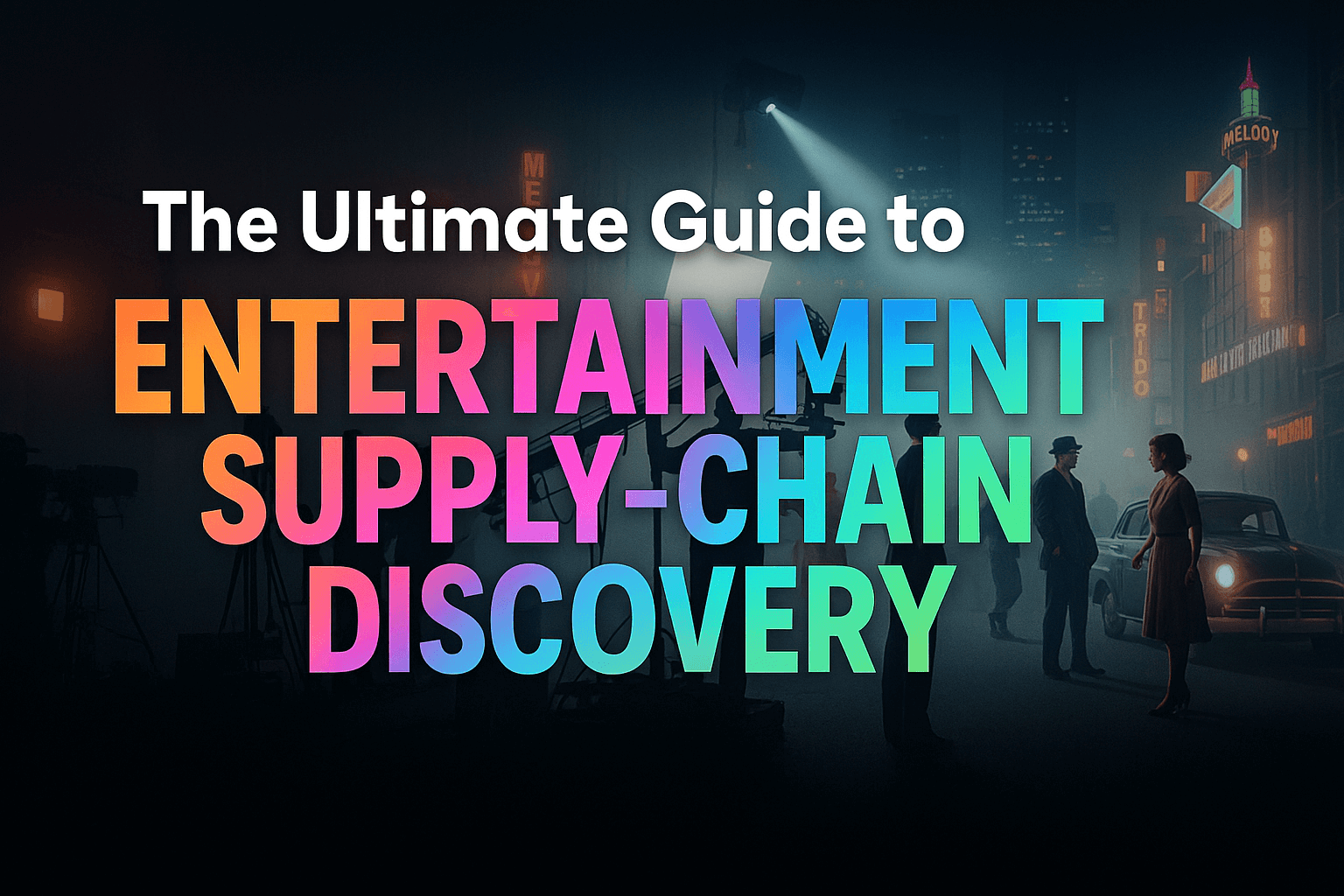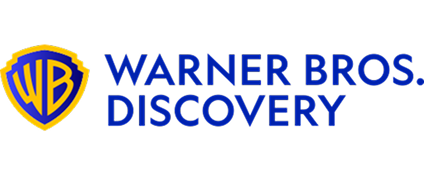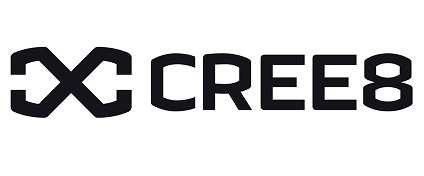The Ultimate Guide to Entertainment Supply-Chain Discovery: Strategy, Challenges, and Data-Driven Solutions

Introduction
For content executives, financiers, and production leaders, the act of finding the right partner—be it a co-production studio, a niche VFX vendor, or a regional distributor—is the foundational strategic act of the business.
Yet, the process remains heavily reliant on insular networks and fragmented data, creating a costly bottleneck. This environment requires a definitive strategic shift toward systematic, data-driven partner identification.
This is The Ultimate Guide to Entertainment Supply-Chain Discovery, a comprehensive playbook for moving beyond traditional methods and establishing a verifiable, global partner scouting operation.
Table of content
- A New Operating Model: Defining Entertainment Supply-Chain Discovery
- The Fragmentation Paradox: Core Challenges in Cross-Border Partner Discovery
- Strategic Value: Why Supply-Chain Discovery is an Executive Mandate
- A New Framework for Entertainment Supply-Chain Discovery: The Data Solution
- How Vitrina Enables Unprecedented Entertainment Supply-Chain Discovery
- Conclusion: The Future of M&E Partner Scouting
- Frequently Asked Questions
Key Takeaways
| Core Challenge | The global M&E supply chain is massive (600,000+ companies) and unmapped, making critical partner discovery inefficient and risky. |
| Strategic Solution | Adopt a centralized, data-first framework that aggregates, verifies, and maps the entire global supply-chain ecosystem in real-time. |
| Vitrina’s Role | Vitrina is the global platform that tracks content projects, companies, and collaborations to turn partner discovery into a verifiable, data-driven workflow. |
A New Operating Model: Defining Entertainment Supply-Chain Discovery
The entertainment supply-chain discovery challenge is not simply a sourcing problem; it is a critical market intelligence deficit.
The B2B M&E supply chain is a sprawling, global system, encompassing an estimated 600,000 companies across content stages—from development and production to localization and final distribution, according to industry census data.
The task of “discovery” requires more than a simple search function. It demands a capability to identify, vet, and engage with the right company at the right stage of the content lifecycle, regardless of its geographic location or niche specialization.
This new operating model recognizes that the traditional approach—relying on trade show attendance, personal contacts, and fragmented, proprietary spreadsheets—is structurally incapable of handling the volume and complexity of the modern content mandate.
As the content landscape fragments globally, driven by international streamer mandates and the quest for regional IP, the need for a precise, data-enabled discovery mechanism becomes non-negotiable.
The goal of this strategic discovery is twofold: efficiency and risk mitigation. Executives must not only accelerate time-to-market by finding qualified vendors faster but also mitigate the high financial and reputational risks associated with cross-border transactions and unvetted partners.
Without a structured discovery system, the industry risks persistent talent shortages and budget overruns that erode profitability.
The Fragmentation Paradox: Core Challenges in Cross-Border Partner Discovery
The media and entertainment supply chain is characterized by a “fragmentation paradox.” While global production has never been more connected, the operational data required to navigate it is more siloed than ever, creating significant friction for senior executives.
The digital media shift, while providing new distribution channels, also introduced complex interoperability issues across a diverse ecosystem of tools and platforms, as noted in a recent analysis on M&E integration challenges. This is not merely a technical challenge; it is a strategic barrier to partnership and growth.
Risk 1: Unmapped Global Expertise and Niche Specialization
The M&E supply chain involves over a thousand different specializations, from specific types of animation to niche localization services for regional dialects. A key pain point for content executives is the inability to find emerging or highly specialized vendors outside of established Tier-1 markets.
- The Invisibility Issue: Thousands of highly capable, mid-sized companies globally remain virtually invisible to major studios and streamers because they lack the resources or contacts to enter traditional networks.
- The Specialization Gap: Traditional discovery methods (e.g., general search engines, word-of-mouth) cannot accurately map a company’s specific expertise (e.g., a VFX house that specializes in water simulations versus one focused on creature work). This leads to costly mismatches, requiring significant time to scout, vet, and ultimately discard unsuitable candidates.
Risk 2: The Data Trust Deficit in Due Diligence
For a senior executive, the risk of a new vendor or co-production partner failing to deliver is a career-defining vulnerability. The most critical information for due diligence—a company’s active project slate, verifiable collaborators, deal track record, and operational capacity—is often opaque, proprietary, or self-reported.
- Verifying Credentials: In cross-border transactions, confirming a company’s operational status, true scale, and recent project involvement is prohibitively difficult. This lack of verifiable data forces reliance on subjective reputation, which is not scalable or auditable. Vitrina’s own analysis on supply chain risk highlights that a lack of vendor and partner due diligence is a primary cause of major project disruptions and cybersecurity vulnerabilities.
- Reputation Mapping: True reputation is built on a chain of verified collaborations. Without a systematic way to see who a company has worked with, on what projects, and which content stages they handled, executives cannot accurately assess future partnership viability. This trust deficit creates significant drag on M&E market intelligence.
Strategic Value: Why Supply-Chain Discovery is an Executive Mandate
The ability to master entertainment supply-chain discovery is now a fundamental source of competitive advantage, directly impacting the bottom line and strategic agility.
- Optimized Time-to-Market: Speed is the new currency in content. Reducing the time spent on identifying, vetting, and contracting partners directly shortens the production lifecycle, allowing content to hit the distribution window faster. This is crucial for maximizing the return on investment (ROI) of a content slate.
- Mitigating Production Risk: By moving beyond general reputation to partner due diligence based on data, executives can pre-emptively manage risk. A system that can flag a vendor’s recent capacity changes or track record on specific genres is an indispensable shield against budget overruns and production delays.
- Unlocking IP Value: Global streamers and studios are constantly seeking specific, localized intellectual property (IP) and talent. Effective discovery allows content acquisition and development teams to quickly identify the small, regional production house that holds the rights to a critically acclaimed book or the studio that excels in a high-demand genre, essentially mapping the hidden arteries of the industry. This is where true content discovery begins to unlock new revenue streams.
A New Framework for Entertainment Supply-Chain Discovery: The Data Solution
The solution to fragmentation is not more manual effort, but a unified, data-powered platform that transforms partner identification from an unstructured search into an algorithmic selection process. This framework requires three essential pillars:
Pillar 1: Unified Data Taxonomy and Real-Time Tracking
The core problem is one of data standardization. The industry lacks a common, granular language to describe production services and company specializations globally.
- The Taxonomy Imperative: A unified taxonomy is required to normalize the language of the supply chain across all regions. It must precisely categorize all 600,000+ companies by function, specialty, location, and proven project history.
- Real-Time Project Tracking: The platform must move beyond static directory listings to track the lifecycle of all film and TV projects from concept through release. This allows executives to see which companies are actively involved in which projects, providing real-time evidence of their current activity and scale. This tracking is the foundation of Vitrina’s core offering, the Film+TV Projects Tracker, which is the necessary component for proactive market analysis.
Pillar 2: Verified Credentials and Reputation Mapping
Data integrity is key to replacing subjective trust with objective verification. The framework must link company profiles to their verifiable track record of collaborators.
- Metadata Management: Every company profile must be enriched with deep, structured metadata management that goes beyond basic contact information. This includes linking their profile to every project they’ve worked on, every major executive, and their specific role in that production.
- The Collaboration Graph: The platform must create a ‘collaboration graph’—a visual and measurable map of who works with whom. For a co-production executive, this immediately shows if a potential partner has a history of successful cross-border transactions or repeat partnerships with known entities. This data transforms opaque reputation into transparent, quantifiable metrics.
Pillar 3: Intent-Based Search and Intelligence
The search function must be as sophisticated as the executive’s needs, capable of translating complex strategic questions into precise, actionable results.
- Semantic Search: This is the shift from searching for keywords (e.g., “VFX”) to searching for meaning (e.g., “VFX company with a verifiable track record in European historical dramas and a current slate under $20M”). The system must utilize AI-powered search to understand the executive’s intent, not just their typed words.
- Competitive Intelligence: The framework must provide tools for competitive analysis. A distribution leader should be able to instantly pull the upcoming slate of a rival streamer, see the production houses they are utilizing, and understand their content investment strategy. This level of M&E market intelligence is impossible with manual research.
How Vitrina Enables Unprecedented Entertainment Supply-Chain Discovery
Vitrina was specifically designed to resolve the fragmentation and data deficit that define modern M&E supply chain discovery. We transform the unstructured, manual process into a systematic, data-driven workflow that is essential for true media supply chain optimization.
Vitrina maintains the world’s most comprehensive census of the global M&E supply chain, covering the 600,000+ companies that power the industry. Unlike traditional databases, Vitrina’s platform is built on a unified data taxonomy that accurately maps every company’s specialization to its verified project history and collaborator network.
This enables executives to:
- Accelerate Partner Sourcing: Use the platform’s intent-based search to find hyper-niche partners globally, instantly. For example, finding a post-production house in South Korea with experience in English-language feature films and a track record of working with US studios is a one-click query.
- Ensure Due Diligence at Scale: Instantly access a company’s full deal track record, active project slate, key decision-makers, and verified collaborators. This allows for rigorous, data-backed partner due diligence, minimizing financial and operational risk before an RFP is even issued.
- Gain Competitive Edge: Track the live production and pre-production slates of competitors to understand their investment focus, identify emerging trends, and preemptively source the partners they are likely to need. This strategic intelligence is the key to mastering your market.
Conclusion: The Future of M&E Partner Scouting
The era of relying on personal networks and fragmented sourcing for high-stakes M&E partnerships is over. The scale, complexity, and global nature of the modern content supply chain demand a new operating model centered on verifiable, real-time data.
Mastering The Ultimate Guide to Entertainment Supply-Chain Discovery means adopting this data-first mindset.
Executives who embrace this framework—moving from keyword search to intent-based intelligence, and from subjective reputation to objective verification—will be the ones who successfully mitigate risk, accelerate content delivery, and consistently unlock the global value of their IP.
The ability to discover, vet, and contract with confidence is no longer a luxury; it is the core strategic competency for success in the next decade of media and entertainment.
Frequently Asked Questions
The primary trends include the global shift toward digital content consumption, the explosive demand for high-quality localized content, and the integration of AI and cloud technologies to address production bottlenecks and manage vast asset libraries efficiently. These forces are driving the need for greater supply-chain discovery to capitalize on regional opportunities.
Due diligence is mission-critical. Failure to properly vet vendors and co-production partners—especially across borders—exposes projects to financial overruns, quality control issues, and serious cybersecurity threats, as many key assets and IPs are handled by external parties.
The single biggest strategic risk is fragmentation. This systemic issue leads to siloed teams, disconnected tools, duplicated assets, and, most critically, an unmapped global ecosystem of partners, making scalable and accurate partner due diligence virtually impossible.
Instead of relying on trade shows, you should use a data platform like Vitrina that allows for a criteria-based search: filter by project history, genre expertise, budget scale, and regional location to find verified co-production partners that precisely match your strategic mandate.















































